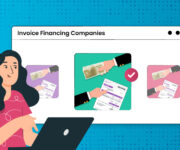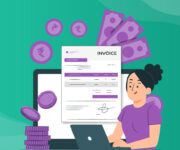Balancing credit sales and liquidity is an unavoidable paradox for all businesses. Small businesses, in particular, might find the task a tall order. It requires diligent management of cash inflows and outflows to ensure the availability of sufficient working capital for the firm’s day-to-day operations. Invoice finance is a short-term borrowing facility that helps to overcome this predicament.
A Brief Intoduction To Invoice Finance
Invoice finance or accounts receivable finance makes future cash flows available for present-day use. Firms use this facility to borrow cash against approved, unpaid invoices and meet their short-term liquidity needs. Lenders pay the invoice value upfront after deducting the margin and applicable charges. When the payments are received on these invoices, the borrower repays the advance amount along with interest and charges, if any.
This article highlights seven major benefits of invoice financing for small enterprises.
1. Prompt Solution To Liquidity Crunch
Invoice finance offers a quick, ‘no fuss-no frill’ facility for raising funds against accounts receivables. The entire procedure is simple and fast, and it usually takes only 24- 72 hours from the time of application to the time of disbursal of funds. Since no collateral is required, many procedural formalities are skipped, resulting in quick processing of the credit facility.
Moreover, the credit is fully serviced as bullet payments when the invoices are settled. This removes the hassle of repaying loans over longer periods.
2. Collateral Free And Easily Accessible
Traditional business financing is usually asset-based and requires collateral for availing of loans. Additionally, lenders often insist on financial statements of past years for credit appraisal purposes. Small businesses and new firms that cannot meet these draconian requirements might borrow from private lenders to meet their fund requirements, which poses a debt-trap risk for them.
On the other hand, Invoice finance provides cash advances to businesses against their unpaid invoices alone. This is especially beneficial to start-up firms that cannot access credit facilities due to the absence of necessary financial statements e.g., previous three years’ balance sheets or two years’ GST return etc.
3. Greater Credit Control And Management
Invoice finance offers firms more flexibility and credit control than any other credit option. Firms can borrow as much money as required and as often as necessary, and they can choose specific customer accounts or specific invoices to finance. Additionally, depending upon the type of invoice finance they choose, firms can decide how much control they have over their payable collection process. This brings us to an important aspect of receivable financing- invoice factoring and invoice discounting, two forms of invoice financing.
In invoice factoring, firms sell their unpaid invoices to lenders, making them responsible for debt collection. The lender advances to the borrower 80% to 85% of the invoice value. The receivables are paid to the lender, releasing the invoice owners from the burden of collections. On receiving the full invoice value, the lending firm will transfer any balance amount to the borrower after deducting interest and charges. The risk of bad debts and late payments is minimized with factoring as the lender is involved in the collection process. They can even run credit checks on your buyer/ client to assess creditworthiness.
Click here to read our article about invoice factoring and how it is changing the landscape for lending companies.
If a business firm opts for invoice discounting, it retains full control of its receivable collection process. The company receives the invoice payment on the due date and clears the outstanding liability with its lender along with processing charges and applicable interest. Using invoice discounting, borrowing firms may receive up to 90% of the invoice value as a loan.
4. Improved Cash-flow Management
With credit sales, funds are usually tied up for 30 to 90 days, depending on the credit period allowed to the buyer. Invoice financing reduces the gap between accounts receivables and accounts payables. Funds thus available are used to clear short-term liabilities like salary disbursal of staff, payment to suppliers, etc. It is also reinvested in the business for growth and expansion.
Small businesses often operate on tight margins. Hence, they cannot provide their buyers with longer credit periods. Timely payment of current liabilities offers leeway for such firms to offer extended credit periods to their loyal customers. Besides, timely servicing of own debts increases the creditworthiness of business firms.
5. More Focus on Core Business
Receivables management uses up considerable manpower, money, time, and effort. Invoice finance provides a quick turnaround of credit to cash so that firms can focus more on their core activity. Instead of chasing debtors, businesses can deploy resources for more productive purposes like improving sales or adopting organizational best practices.
6. Better Margins and Cost Effectiveness Compared to Loans and Overdrafts
Every penny counts in cash-strapped trade situations. Companies will look for the maximum borrowable limit to overcome the cash crunch. Banks and other financing firms often keep 20% to 25% of the assessed value as a margin for loans and overdrafts. Invoice financing offers higher margins, i.e.,80% to 90% of invoice value as advances, which is a better bargain for the firms.
Loans and overdrafts also have recurring service charges collected every quarter. In invoice financing, the service charge or fee (a percentage of the borrowed amount) must be paid only once. With interest rates in double digits, servicing business loans in the long term will eat into the business’s profits. Invoice finance is a cost-effective alternative to expensive business loans.
7. Acquiring Working Capital Without Compromising Balance Sheet Strength
This might sound like a chartered accountant’s jargon, but it neatly sums up whatever we have discussed here. Ultimately, a balance sheet is a business’s health card. Too many short-term debts to cover high levels of short-term receivables is never good for a business. Invoice finance free up locked funds without majorly disrupting the asset-liability balance.
A Quick Glance At Indian Invoice Financing Scenario
Let us wind up with a quick review of the Indian invoice financing market.
The SME sector accounted for nearly 30.50% of India’s GDP in FY 2018-19. In a survey1 conducted among 800 SME units, it was observed that at least Rs. 15 lakh crores worth of invoice funding is needed in the SME sector every year. This data reveals a vast untapped market for invoice financing in India. With the Factoring Regulation Act of 2021 and the online bill discounting platform TReDS (Trades Receivables Discounting System, the government aims to boost invoice funding for SMEs.
Finezza offers comprehensive Loan Management, Loan Organization, and Collection Delinquency Management products for lending institutions, aiming to streamline cumbersome loan processing. Want to find the right product for your lending business? Contact us today!




Leave a Reply